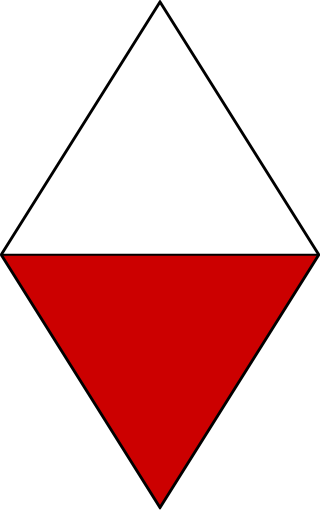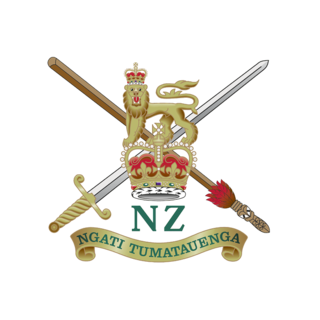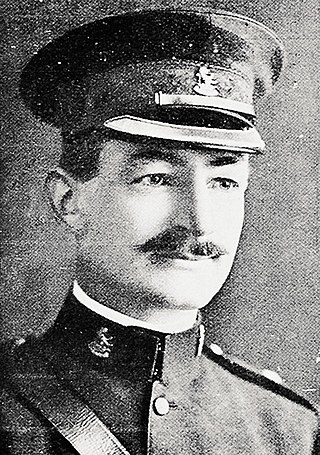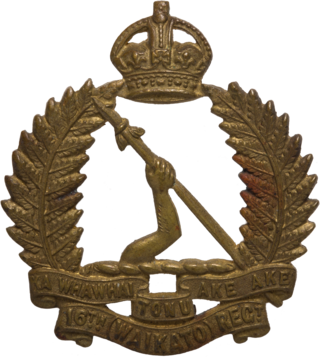
The 42nd Infantry Division was an infantry division of the British Army. The division was raised in 1908 as part of the Territorial Force (TF), originally as the East Lancashire Division, and was redesignated as the 42nd Division on 25 May 1915. It was the first TF division to be sent overseas during the First World War. The division fought at Gallipoli, in the Sinai desert and on the Western Front in France and Belgium. Disbanded after the war, it was reformed in the Territorial Army (TA), in the Second World War it served as the 42nd Infantry Division with the British Expeditionary Force (BEF) and fought in Belgium and France before being evacuated at Dunkirk. The division was later reformed in the United Kingdom and, in November 1941, was converted into the 42nd Armoured Division, which was disbanded in October 1943 without serving overseas. A 2nd Line duplicate formation, the 66th Infantry Division, was created when the Territorials were doubled in both world wars.

The New Zealand Expeditionary Force (NZEF) was the title of the military forces sent from New Zealand to fight alongside other British Empire and Dominion troops during World War I (1914–1918) and World War II (1939–1945). Ultimately, the NZEF of World War I became known as the First New Zealand Expeditionary Force. The NZEF of World War II was known as the Second New Zealand Expeditionary Force (2NZEF).

The South Lancashire Regiment was a line infantry regiment of the British Army in existence from 1881 to 1958.

The Royal New Zealand Infantry Regiment is the parent administrative regiment and corps of regular and reserve infantry battalions in the New Zealand Army. It was originally formed in 1947 with a singular Regular regiment and multiple reserve regiments. Over time, the regiments were turned into battalions, the reserve units amalgamated and more regular units raised and disbanded. Currently, the Regiment currently consists of two regular and three reserve battalions. Throughout its existence, units raised in this regiment have served and deployed on operations in Malaya, Vietnam, Borneo and various United Nations peacekeeping operations.
The Wellington (City of Wellington's Own) and Hawke's Bay Regiment was a Territorial Force regiment of the New Zealand Army. It was formed in 1964 during the reorganisation of the army by the amalgamation of two separate regiments:
The 4th Division was one of three home defence divisions of the New Zealand Military Forces formed during World War II. The unit was established on 1 November 1941 and was responsible for protecting the southern part of New Zealand's North Island from invasion. The division was greatly reduced in size during 1943 and was disbanded on 1 April 1944 without seeing combat.

The 5th/7th Battalion, Royal New Zealand Infantry Regiment is an Army Reserve infantry battalion of the Royal New Zealand Infantry Regiment with its headquarters in Trentham, New Zealand.

Major General Sir William Henry Cunningham was an officer in the New Zealand Military Forces who served during the First and Second World Wars.
The Wellington Infantry Regiment was a military unit of the New Zealand Expeditionary Force (NZEF) raised for service in the First World War. It saw service in the Gallipoli Campaign (1915) and on the Western Front (1916–1919). The regiment was formed by grouping together companies from four different territorial regiments base in the Wellington Military district.

The Taranaki Regiment was a territorial infantry regiment of the New Zealand Military Forces. The regiment traced its origins to the Taranaki Volunteer Rifle Company, a volunteer corps formed in 1858 and which saw service in the New Zealand Wars. The volunteer corps also provided men to the New Zealand contingents sent to South Africa during the Second Boer War and in 1911 became the 11th Regiment (Taranaki Rifles). During the First World War, the regiment provided a company to each of the battalions of the Wellington Infantry Regiment and saw combat at Galipolli and on the Western Front. After the war the regiment was renamed the Taranaki Regiment and remained in New Zealand for home defense during the Second World War. Men from the regiment, however, served with the 19th, 22nd, 25th and 36th Battalions of the Second New Zealand Expeditionary Force. In 1948, the Taranaki Regiment was amalgamated with the Wellington West Coast Regiment and became the Wellington West Coast and Taranaki Regiment.

The Wellington Regiment (City of Wellington's Own) was a territorial infantry regiment of the New Zealand Army. The regiment traced its origins to the Wellington Veteran Volunteer Corps, a volunteer corps formed in 1867 and which would later amalgamate with other volunteer corps to form the 5th (Wellington) Regiment in 1911. During the First World War, the regiment was first sent to capture German Samoa in August 1914 and was later affiliated with the New Zealand Rifle Brigade which saw combat on the Western Front. After the war, the regiment was renamed the Wellington Regiment and remained in New Zealand for home defence during the Second World War. Men from the regiment, however, served with the 19th, 22nd, 25th and 36th Battalions of the Second New Zealand Expeditionary Force. In 1964, the Wellington Regiment was amalgamated with the Hawke's Bay Regiment to become 7th Battalion (Wellington (City of Wellington's Own) and Hawke's Bay), Royal New Zealand Infantry Regiment. The 7th Battalion was itself later amalgamated with the 5th Battalion and became 5th/7th Battalion, Royal New Zealand Infantry Regiment in 2012. The traditions of the Wellington Regiment are now continued by Wellington Company, 5/7 RNZIR.

The Hawke's Bay Regiment was a territorial infantry regiment of the New Zealand Military Forces. The regiment traced its origins to the Napier Rifle Volunteer Rifles, a volunteer corps formed in 1863 and which would later amalgamate with other volunteer corps to form the 9th Regiment in 1911. During the First World War, the regiment provided a company to each of the battalions of the Wellington Infantry Regiment and saw combat at Galipolli and on the Western Front. After the war the regiment was renamed the Hawke's Bay Regiment and remained in New Zealand for home defense during the Second World War. Men from the regiment, however, served with the 19th, 22nd, 25th and 36th Battalions of the Second New Zealand Expeditionary Force. The regiment had a close relationship with the Ruahine Regiment, which was detached and reabsorbed by the Hawke's Bay regiment on two separate occasions. In 1964, the Hawkes Bay regiment was amalgamated with the Wellington Regiment and become the 7th Battalion, Royal New Zealand Infantry Regiment

The 2nd Regiment was a territorial infantry regiment of the New Zealand Military Forces. It was formed in 1911 from various volunteer corps raised during the second half of the nineteenth century. Men from the regiment saw combat in the First World War as part of the Canterbury Infantry Regiment. It was amalgamated with the 1st (Canterbury) Regiment in 1921 to form the 1st Battalion, Canterbury Regiment.
The 1st (Canterbury) Regiment was a territorial infantry regiment of the New Zealand Military Forces. It was formed in 1911 from various volunteer corps raised during the second half of the nineteenth century. Men from the regiment saw combat in the First World War as part of the Canterbury Infantry Regiment. It was amalgamated with the 2nd Regiment in 1921 to form the 1st Battalion, Canterbury Regiment.
The 13th Regiment was a territorial infantry regiment of the New Zealand Military Forces. It was formed in 1911 from various volunteer corps raised during the second half of the nineteenth century. Men from the regiment saw combat in the First World War as part of the Canterbury Infantry Regiment. It was amalgamated with the 12th Regiment to form the 2nd Battalion, Canterbury Regiment in 1921, which was redesignated as the 1st Battalion, Nelson, Marlborough and West Coast Regiment in 1923.
The 12th Regiment was a territorial infantry regiment of the New Zealand Military Forces. It was formed in 1911 from various volunteer corps raised during the second half of the nineteenth century. Men from the regiment saw combat in the First World War as part of the Canterbury Infantry Regiment. The 12th Regiment was amalgamated with the 13th Regiment in 1921, forming the 2nd Battalion, Canterbury Regiment, which was then redesignated as the 1st Battalion, Nelson, Marlborough and West Coast Regiment in 1923.
The Wellington West Coast Regiment was a territorial infantry regiment of the New Zealand Military Forces. The regiment traced its origins to the Wanganui Rifle Volunteers, a volunteer corps formed in 1860. The volunteer corps provided men to the New Zealand contingents sent to South Africa during the Second Boer War and in 1911 became the 7th Regiment. During the First World War, the regiment provided a company to each of the battalions of the Wellington Infantry Regiment, which saw combat at Galipolli and on the Western Front. After the war the regiment was renamed the Wellington West Coast Regiment and remained in New Zealand for home defence during the Second World War. Men from the regiment, however, served with the 19th, 22nd, 25th and 36th Battalions of the Second New Zealand Expeditionary Force. In 1948, the Wellington West Coast Regiment was amalgamated with the Taranaki Regiment and became the Wellington West Coast and Taranaki Regiment.

The New Zealand Machine Gun Corps was an administrative corps of the New Zealand Military Forces during the First World War. It was formed in early 1916, following the Gallipoli campaign in response to a need for more effective machine gun support. The corps initially comprised independent machine gun companies and a mounted machine gun squadron, although in 1918 the machine gun companies were brought together into a machine gun battalion. The New Zealand Machine Gun Corps was disbanded at the end of the war.

The Waikato Regiment was a territorial infantry regiment of the New Zealand Military Forces. The Regiment was formed in 1911 as the 16th (Waikato) Regiment and provided service companies to the Auckland Infantry Regiment during the First World War. Men from the Regiment also served with the 18th, 21st, 24th and 29th battalions of the 2nd New Zealand Expeditionary Force during the Second World War. The regiment was absorbed by the 1st Armoured Regiment (Waikato) of the Royal New Zealand Armoured Corps in 1950

The Northland Regiment was a territorial infantry regiment of the New Zealand Military Forces. The Regiment was formed in 1911 and provided service companies to the Auckland Infantry Regiment during the First World War. Men from the Regiment also served with the 18th, 21st, 24th and 29th battalions of the 2nd New Zealand Expeditionary Force during the Second World War. The regiment was amalgamated with the Auckland Regiment in 1964, becoming 3rd Battalion, Royal New Zealand Infantry Regiment.














